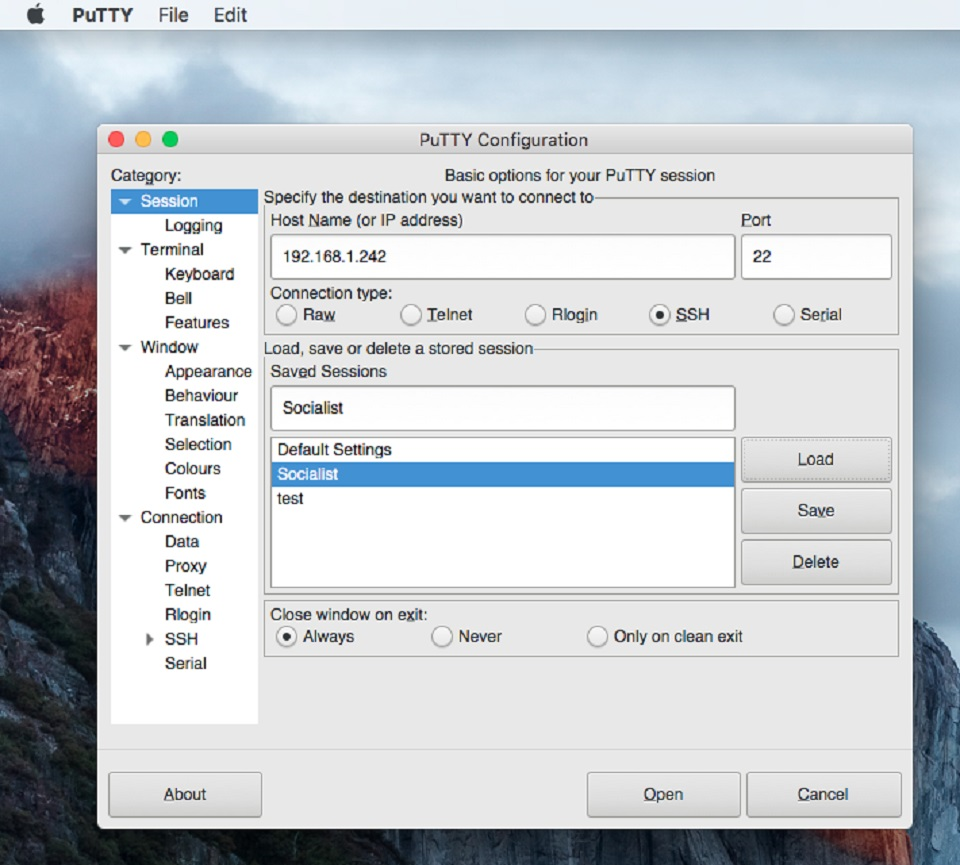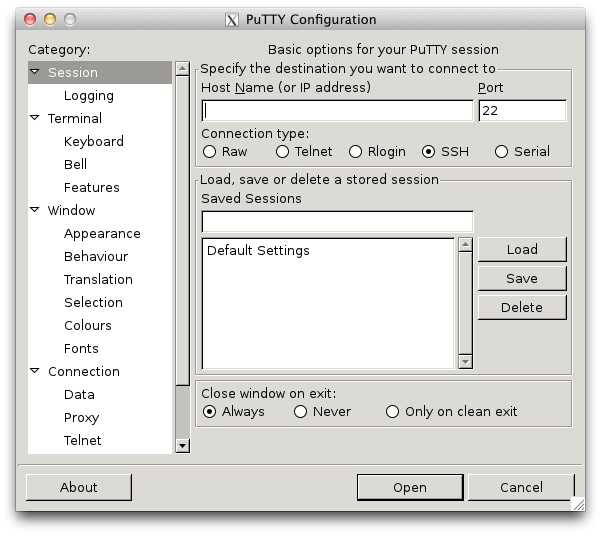

- Putty for mac os sierra how to#
- Putty for mac os sierra install#
- Putty for mac os sierra software#
- Putty for mac os sierra code#
- Putty for mac os sierra license#
Putty for mac os sierra code#
This is two-factor authentication, so you will be shown a code that you must enter before you can finally log in. Next, go to this link, enter your Apple ID username/email and password, and log in.
Putty for mac os sierra install#
Note that, at the time of writing, in order to install Xcode on your Mac, your macOS will need to be upgraded to macOS Monterey.First, go to the Mac App Store, search for Xcode, and click the Xcode app (which should be the first result).
Putty for mac os sierra how to#
The good news is that all of this can be done for free, so if you have some time and patience to complete the different steps of the installation process, here are the details of how to download PuTTY on your Mac:
Putty for mac os sierra license#
Next, accept the Xcode license agreement, install MacPorts, and after that use the built-in Terminal app to finally install PuTTY on your Mac.Īs you can see, the process of downloading and installing PuTTY on a Mac isn’t particularly straightforward, and some preparation is required to get everything working. To download PuTTY for Mac, you must first download and install Xcode and download and install Xcode Command Line Tools. This can speed up the process of logging back into SSH servers in the future, and also makes switching between SSH servers quicker and more convenient. Other notable things that you can do in PuTTY that you can’t do in Terminal are saving your login data and saving information about your previous sessions. Note that you’d still need to use commands for most of your work, but having a GUI for the tool’s settings can still be very helpful. This interface can help with using PuTTY’s command line by allowing you to customize its settings in a more convenient way, rather than having to do everything by entering commands into the command line. However, the thing that may make downloading and installing PuTTY and using it instead of your Mac’s Terminal is that the latter offers a graphical user interface (GUI). For the most part, Terminal and PuTTY can be used in the same way. Your Mac already has a built-in SSH client – the Terminal tool that you can find in the Utilities folder. PuTTY is available on Mac through its macOS port. I'm quite disappointed with this engineering decision, but even more so, the fact they haven't corrected what I along with most other people on this thread think is an obnoxious interference into how experienced developers work.PuTTY is a Windows SSH client that’s also available for Mac – unlike other SSH clients, this tool offers a user interface and allows the user to save their login data and session information. In fact, I've also signed up for a small corporate plan on GitHub and have moved most of my new work there instead of BitBucket, so that I can more effectively use GitHub Desktop or their GUI for Pull Request management, something prompted largely due to this irritation. But to be honest, until they restore an ability for me to use MY OWN NAMING CONVENTION for the dozens of ssh keys I have to deal with, I have no interest in giving them another chance. Good to know symlinks work, should I ever decide to give these guys a chance again.

That's the reason I haven't come back here since my original post, until getting another message today from this thread and getting curious.
Putty for mac os sierra software#
There should be a way to specify the location of an existing ssh key!Īnother option, and the one I chose, is to switch to Github Desktop, as I really don't like a software vendor who breaks existing, widely-expected intuitive behavior without warning, and then ignores customer complaints about it for months. Not letting me use my existing ssh key is a recipe for losing me as a customer - I don't like being forced to change the way I work. Why can't I use the ssh key which I want to use? Why isn't this finding my default ssh key like all other programs I have which use ssh, including earlier versions of SourceTree. Now, I see no way to specify this key, it's not being found despite being in the normal location on Mac/Linux systems, and it seems the only way to use ssh is to generate a new ssh key - WHICH I DO NOT WANT TO DO. I used to be able to use this with SourceTree. Now, I get a message "no key found", despite the fact I have ~/.ssh/id_rsa defined, it's in my agent and Apple keychain, and I can use this fine everywhere else. Before, I could pick one of my ssh keys (I have dozens, but mainly use one for work and another for personal Git repos) during setup. It seems there is some change to how the setup and configuration of SSH keys work. I'm on a new project where I have to collaborate with some people on Windows and suggested they use SourceTree, and wanted to re-install SourceTree on my macs so I could help them learn this by demonstration, as I have used this from time to time in the past. I normally use the command line git client to work with GitHub or BitBucket. I just rebuilt my laptop and iMac with clean installs of MacOS Sierra.


 0 kommentar(er)
0 kommentar(er)
